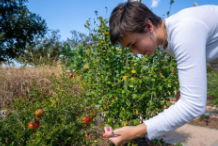Reports of tomato anthracnose are increasing so it’s time to share some information about how this disease spreads and what can be done about it. As with many problems of the garden, preventative efforts go a long way.
Description: High humidity and frequent rainfall favor development of the fungal disease, anthracnose. Most often seen in the later part of the growing season on ripe fruit, anthracnose reduces the quality and yield of the tomato harvest.
Damage: Symptoms begin as small, circular lesions that are slightly depressed on the surface of the fruit. Spots grow both in diameter of the circles and the depth of the depressions. The sunken lesions give a water-soaked appearance beneath the skin of the fruit. At the center of the lesions are black, concentric rings which are small fruiting structures (acervuli). This is the disease-causing fungus.
During humid weather, the fruiting structures release buff-colored fungal spores (conidia). As lesions grow, they can join and cause the fruit to decay which promotes microorganisms to invade and rot the fruit entirely.
Control: Anthracnose spores survive in plant debris and soil. Spores can get splashed onto fruit during a heavy rain or even with overhead watering. This continues the spread of the disease. Proper cultural practices can prevent this by using mulch over the soil around the tomato plants and removing plant debris from the ground. Promote air flow to reduce humid conditions by staking the tomato plants. Use drip irrigation or a soaker hose to prevent splashing spores onto plants.
Chlorothalonil is effective and has a 0-day waiting period from application to harvest. Products that contain chlorothalonil include, but are not limited to, Fertilome Broad Spectrum Landscape & Garden Fungicide; Ortho Garden Disease Control; Bonide Fungonil Concentrate; Hi-Yield Vegetable, Flower, Fruit and Ornamental Fungicide and GardenTech Daconil.
Cynthia Domenghini, Extension Agent




